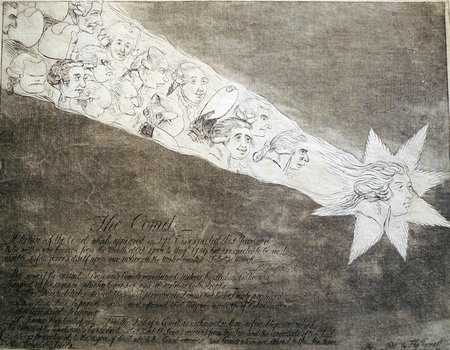James Sayers (1748-1823), The Comet, 18 February 1789. Etching and aquatint. Published by Thomas Cornell, London. Graphic Arts Collection GA2013- in process.
Originally trained as an attorney, James Sayers (active 1748-1825) drew the first British caricature using the symbolism of a comet (later copied many times). His print was released on February 18, 1789, the day before the scheduled third reading of the Regency Bill, which would take power away from George III (1738-1820). Happily, the King’s porphyria had begun to recede in January and by early February, various politicians were leaving Charles Fox (1749-1806), and returning to the side of King George and William Pitt (1759-1806).
Sayers’s comet is headed by the Prince of Wales, a possible allusion to Louis XIV, the Sun King. Here, it is George III who is the unseen sun. Riding on the tail of the Prince are Richard Brinsley Sheridan; Fox; William, 3rd Duke of Portland; Sir Grey Cooper; John Warren, and several others.
The text of the print, which is difficult to read, has been transcribed by the British Museum:
“A Return of the Comet which appeared in 1761 [1762] is expected this Year and to be within our horizon from the month of Octr 1788 to Augt 1789 but is expected to be most -visible (if it forces itself upon our Notice) in the Winter months Febry & March ——— vide Dr Trusslers Almanack…”
“…Sr Isaac Newton asserts That the Tail of a Comet is nothing else than a fine Vapour which the Head of the Comet emits by its heat that Heat the Comet receives from the Sun and the magnitude of the Tail is always proportional to the degree of heat which the Comet receives, and Comets which are nearest to the Sun have the longest Tails———”

